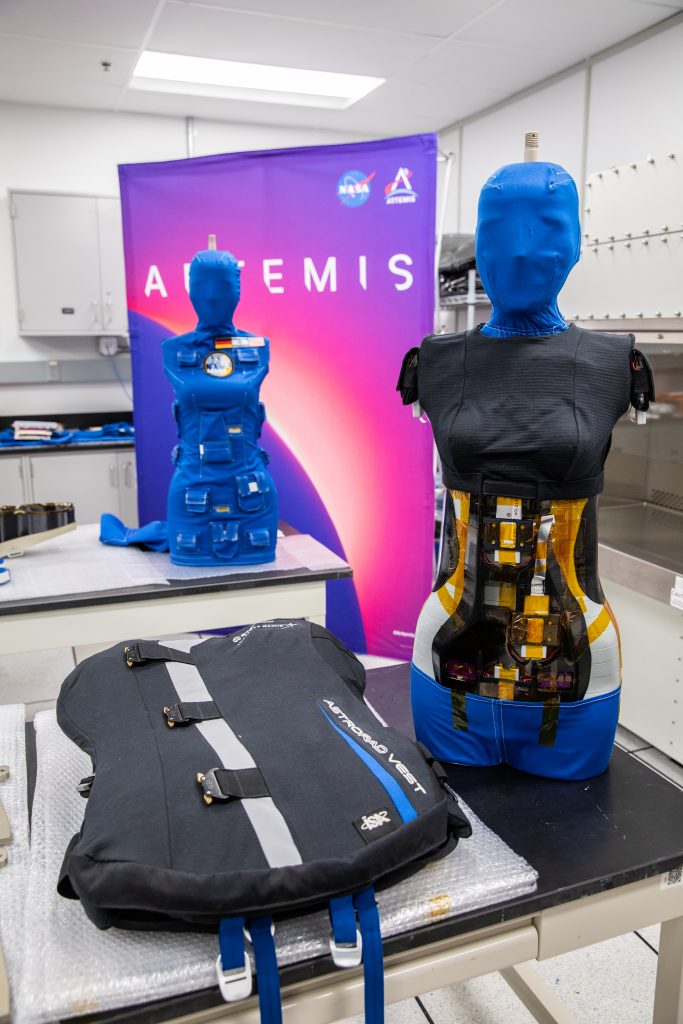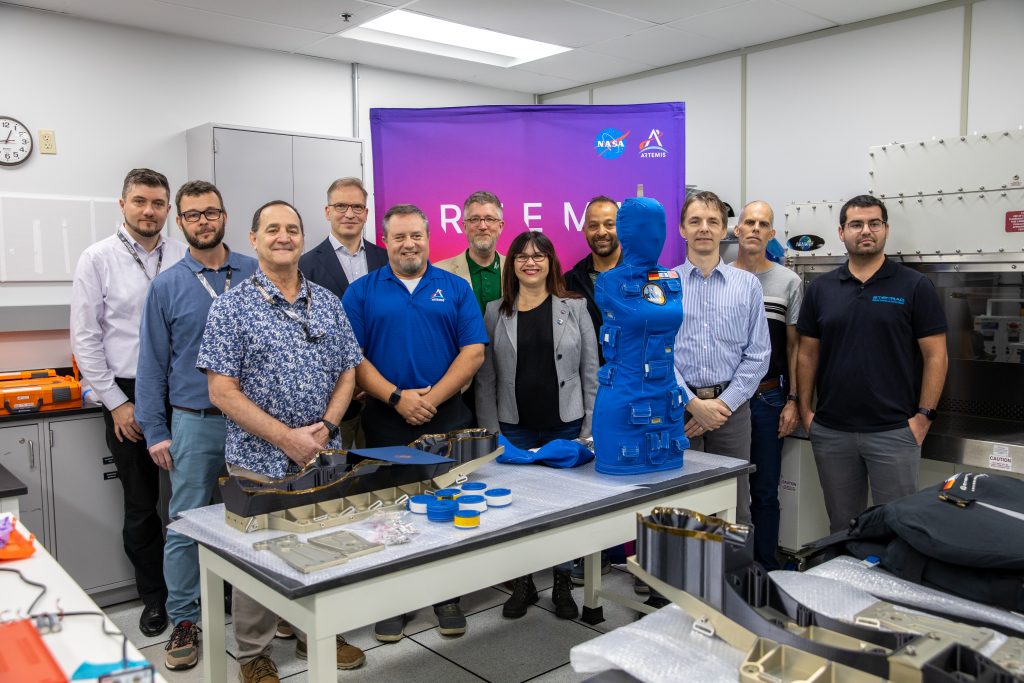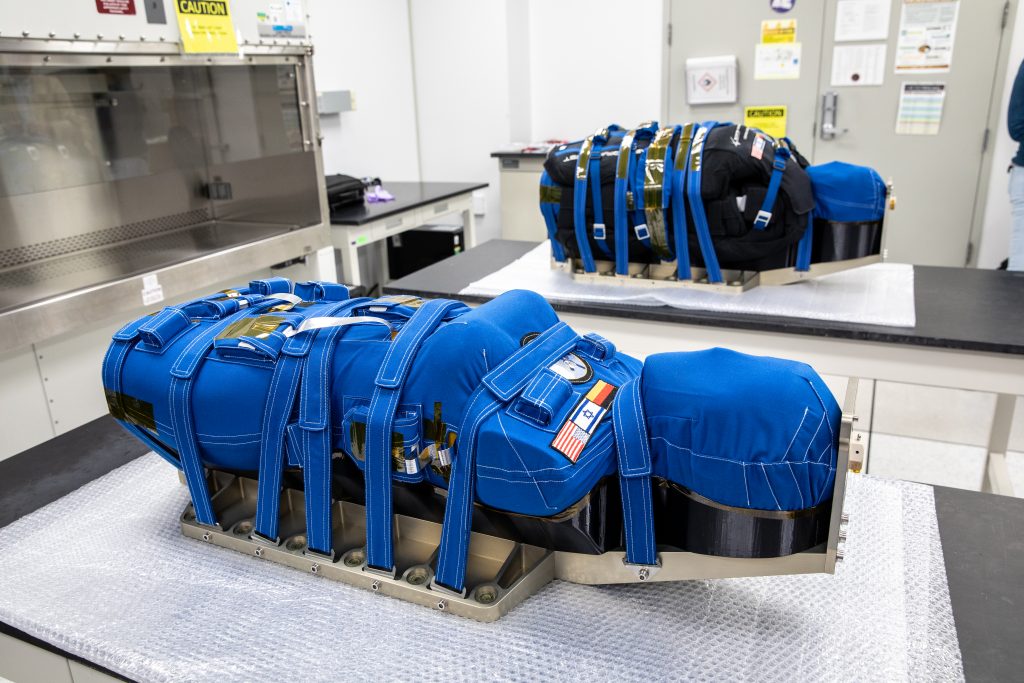Female-shaped phantoms Helga and Zohar are back at the Artemis I launch site following a 25-day trip inside the Orion spacecraft. Both mannequins measured radiation levels over the entire Artemis mission until landing, and have just been handed over by NASA to the German Aerospace Center, DLR, research team.
“We are examining their radiation detectors directly here at Kennedy Space Center and reading out their measurement data,” says MARE project manager Thomas Berger from DLR’s Institute of Aerospace Medicine.

“We already have excellent data spanning the first to the last minute of flight. Helga and Zohar did an excellent job on their journey to the Moon!”, he adds.
Following this initial evaluation and the removal of the detectors on site, the team will conduct a detailed study of the measurements acquired at distances of up to more than 400 000 kilometres from Earth.
The results will provide a three-dimensional image of the human body, showing the amount of radiation exposure on bones and organs during a lunar flight.

Lunar twins
The two astronaut phantoms are modelled on female bodies made of 38 slices filled with sensors. They measured the dose experienced in the body over the entire flight, including the most radiation-sensitive organs – the lungs, stomach, uterus and bone marrow. In addition to those, more than 12 000 radiation detectors made of small crystals were spread out all over the mannequins.

Unlike Helga, Zohar wore a vest to explore how much it reduced the radiation exposure as a first step to protect astronauts in future space missions. This evaluation will be carried out at DLR in Cologne, with contributions from the laboratories of the NASA project partners and international universities.
Helga and Zohar will be back at the Institute of Aerospace Medicine in Cologne, Germany in February.
Update 31-01-24: It’s been a while since we’ve heard from Helga and Zohar, our female phantoms from Artemis I. These mannequins enjoyed a 25-day trip inside the Orion spacecraft, measuring radiation levels during the entire mission. Teams from NASA, the DLR’s Institute of Aerospace Medicine and from universities all over the world have been examining the data from over 12 000 passive and 34 active radiation detectors and are busy analysing the results ahead of publication this year – as soon as we know more, we will share it with you.
Update 18/09/24: The initial findings from this experiment have been published today in Nature. The measurement results show that radiation exposure inside the Orion spacecraft varied significantly depending on detector location, with the most shielded area of the capsule remained below 150 millisieverts, a safe level for avoiding acute radiation sickness. The spacecraft’s orientation also affected radiation exposure; a 90-degree turn during Orion’s flyby of the inner Van Allen belt reduced radiation exposure by 50%, providing valuable information for future mission designs. The scientific team concluded that radiation exposure on future Artemis missions is unlikely to exceed NASA limits for astronauts, confirming Orion’s suitability for crewed missions. Find out more here.

 Automated Transfer Vehicle page
Automated Transfer Vehicle page ATV blog archive
ATV blog archive
Discussion: 9 comments
When will we get the full dataset released? Will a comparison be made of the alleged radiation datasets from Apollo, Mercury and Unmanned flights? Will the dataset be whole and unadulterated data? I.E. No assumptive data added and all data included with no filters?
The data from the MARE experiment first needs to be retrieved, processed and analysed by the experiment scientists. They have first access. The radiation data experiments gathered within Orion are all based on international collaboration between the space agencies and universities from around the world. All data exchange and subsequent publication are therefore coordinated. Some data could be restricted but eventually most will be released in scientific journals. Stay tuned!
I am very curious about this data! ESA let us know a previous analysis about it?
We will definitely be posting updates here when we have them!
Greetings! any basic findings yet available on radiation effects? 5 months from article date. Is e.g. the harmful crossing of VanAllen belts myth busted? At least some core conclusions should be formulated, thx!
Any update on this? The information is very important and sharing the data simple
Curious is that more than 5 months have passed and until now nothing has been released.
Even though the data is “recovered” (from all hardware, being it the ESA EADs and the MARE hardware with the two phantoms Helga and Zohar – which included over 10.000 radiation detectors) the full data analysis has to take some time, cause this is (as for all scientific experiments) – but especially for Artemis I a precious set of data. Nevertheless – as for every science experiment – first we have to analyze the data, then we are publishing it – and as soon as it is published the data will be available for everybody.
This is too cool!! Only article I can find on this.
Please keep me in the loop. ?